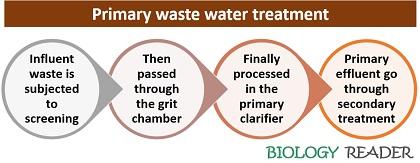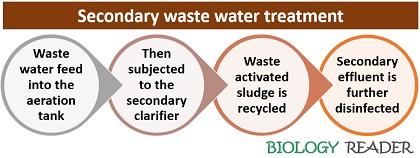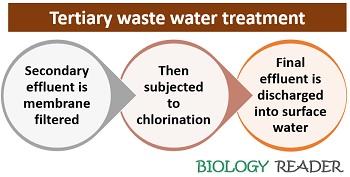Activated sludge treatment can define as a conventional method, which can separate the solid wastes, suspended organic matter, soluble matter and parasites. It is a biological system that makes the use of living bacterial flocs to degrade the organic matter of the sewage and industrial waste in aerated bioreactors.
Activated sludge treatment involves a series of stages, which firstly separates the raw or primary sludge, then separates the waste activated sludge and finally involves disinfection and clarification of the effluent. Therefore, it contributes a significant role in the control of water pollution by eliminating the undesired chemicals, particulate matter and parasites from the sewage and industrial waste.
Content: Activated Sludge Treatment
Definition of Activated Sludge Treatment
Activated sludge treatment can define as the wastewater treatment plant, which eliminates the particulate matter like sand, unwanted inorganic and organic wastes and harmful microorganisms from the sewage waste. The process is followed by the primary, secondary and tertiary treatment methods.
Primary treatment is a physical method, which involves the separation of large solid matter like leaves, sand, gravel particles etc. Secondary treatment is a biological method, which separates the suspended and soluble organic matter by making the use of bacterial flocs. Tertiary treatment is a chemical method, which is a final stage to disinfect the secondary effluent by making the use of chlorine gas.
Variables used in the Activated Sludge Treatment
While studying the activated sludge treatment, we must have an idea of the terms given below:
Water pollution
It can define as the accumulation of invaluable physical, biological and chemical waste, which alters the appearance and potability of the water. Ground water generally gets polluted when it flows through water channels, while the surface water gets contaminated by waste released from the various kind of establishments.
Water pollutants
It includes chemical wastes (like heavy metals, VOCs), physical wastes (like vegetable remainings, sand, gravel etc.) and biological waste (such as coliform bacteria in the human and animal’s faeces). Water pollutants change the water quality or make it undesirable or unpotable for human consumption.
Activated sludge
It can define as waste formed in the secondary treatment by the oxidation of organic matter by the bacterial flocs under aerated condition. The coarse particles, colloids, suspended or dissolved matter etc. deposits at the bottom of the aeration basin is termed as sludge. This sludge contains active biomass of aerobic microbes like bacteria, fungi, protozoans etc. that decompose the waste into activated sludge under aerated condition.
Sedimentation
It is a physical process facilitating the solid-liquid separation based on the size and density of the particles suspended in the solution—the coarse particles deposits at the bottom as sediment out of fluid via gravitational force. In the case of wastewater treatment, the sediment is called sludge.
Flocculation
This method facilitates the clumping of particles suspended in a liquid, which generally appears as flocs that settle down towards the base of chamber or reactor. In simple words, it is the aggregation of small colloids towards the bottom out os liquid mixture by the use of flocculating agents.
Biodegradation
It is a process of removing organic and inorganic waste via active biomass of microorganisms, which cause decomposition of the organic matter into a simpler form. In this, the products formed after the biodegradation are environment-friendly or does not cause any destruction to the environment.
Disinfection
This is a chemical process used to destroy or deactivate the pathogenic microorganisms by using various disinfectants (like chlorine, ozone, etc.) in order to make the water potable for human consumption.
Mixing regime
It can define as the process of mixing of the contents in a bioreactor, followed by either plug flow or complete mixing. There is a lateral mixing of the contents in plug flow mixing, while in a complete mixing the contents are mixed or distributed uniformly. This factor may affect the oxygen requirement, the susceptibility of the microorganisms to shock load, conditions within the bioreactor etc.
Retention time
It can define as the average time, in which wastewater remains in the aerobic digester. It is also called hydraulic retention time or sludge retention time.
Important Notes
- The main objective of traditional activated sludge treatment is to recycle the activated sludge of sewage and industrial waste.
- It makes the use of physical techniques like sedimentation in both the primary and secondary treatment to separate and filter the bulky, solid or particulate waste.
- Activated sludge treatment also uses different aerobic bacterial flocs so that they can further degrade the suspended and soluble organic waste.
- It also uses a chemical method of disinfection in order to kill or deactivate the growth and reproduction of pathogenic microorganisms, especially coliforms.
- The biodegradation of organic matter occurs inside the aeration tank or basin, which is provided with the blower or air compressor to maintain the aerobic condition.
- Its retention time is in between 5-14 hours.
- This method of wastewater treatment aids maximum elimination of coarse particles, BOD, COD and pathogenic microorganisms or parasites.
Activated Sludge Process
The whole process is divided into primary, secondary and tertiary treatment methods, where each uses different mechanics to produce effluent from the wastewater.

Primary Treatment
It involves a series of operation like:
Screening: The raw-sewage waste goes into the bar rack screening via pipe inlets, in which the coarse solids like rags, debris etc. are eliminated by interception. This step efficiently removes the floatable matter and algae.
Grit disposal: It is carried out in the grit chamber, in which particles like sand, gravel, cinders etc. deposit at the bottom relative to their different densities.
Pre-treatment or Primary sedimentation: It is accomplished by the use of primary clarifier or a basin, where water has a certain retention time where the heavy organic solids can sediment (suspended solids). This step ensures elimination of the suspended solids (about 50-70%) and the BOD (nearly 25-40%).

Secondary Treatment
It is the most crucial step of the wastewater treatment, which filters out the effluent from the waste activated sludge. The secondary treatment involves a series of operation, such as:
Aeration tank: It a bioreactor which contains the primary or raw sludge and a microbial suspension. Aeration tank is provided with an air compressor, which maintains the continuous airflow within the reactor. Inside the aeration basin, the microorganisms utilize or decompose the organic matter in order to release carbon dioxide, water, energy and simpler compounds.
Secondary sedimentation: It makes the use of clarifier settler, which further facilitates the solid-liquid separation of the waste activated sludge. The solid waste settled at the bottom of the secondary clarifier is further recycled into the aeration tank via return sludge pump. In contrast, the wastewater from the activated sludge is further subjected to disinfection.

Tertiary Treatment
It is the final stage, in which the secondary effluent is treated chemically to ensure the release of high-quality effluent.
Media or Membrane filtration: The remaining particulate matter, dissolved solutes and microbes in the secondary effluent is then separated out by employing ultra-filtration or micro-filtration technique.
Disinfection: The wastewater coming out of the secondary treatment is called secondary effluent, which can be either subjected to UV-disinfection, chlorination or ozonation.
Advantages
- The process of activated sludge treatment releases high-quality effluent (wastewater released from the sewage).
- It ensures the maximum reduction of BOD and parasites upto 99% during the secondary treatment of wastewater.
- Activated sludge process can resist different organic and hydraulic shock load.
- The activated sludge treatment plant can be established in the minimal land area compared to the water stabilization pond.
- It also ensures maximum removal of nutrients like N2, K, Ph from the organic matter.
Disadvantages
- The activated sludge process requires high capital.
- It also requires a continuous electricity supply.
- Its operation and maintenance require skilled labour-power.
- The process cannot be established at the community level.
- The construction of an activated sludge plant requires expert design, and generally, all are equipment’s are not locally available.
- Effluent from the wastewater requires proper disinfection and appropriate discharge.
Conclusion
Therefore we can conclude that the activated sludge treatment is a widely accepted model for the processing of solid-liquid domestic and industrial waste. It makes the use of microbial flocs (contains bacteria and protozoa), oxygen (for cell respiration) and sludge recycling system (activated sludge is processed back). The effluent produced by the activated sludge treatment is free of contaminants and can be safely disposed into the surface water.

When you talked about the entirety of the sludge treatment process and how it can be done in a relatively small space, it really opened my mind. My apartment building has been experiencing some issues with the sewage system and the management wants to do something about it. I’ll make sure they hire a professional to resolve the matter immediately.